Cervélo S5 review: A truly exhilarating superbike
This article originally appeared on Velo News
This story originally ran on CyclingTips
They say you shouldn't judge a book by its cover. If the Cervelo S5 was a book, I am very much guilty of said offence.
On paper - as a competitive rider with the mushiest of soft spots for aero gains and a love for time trialling - the S5 should be the only bike for me. It's an unapologetically race-focused aero bike with more than a hint of time trial frame design.
Rightly or wrongly, though, the recent iterations of the S5, with their nose cone-like external fork steerer, V-stem, steeply sloping top tube, and rear wheel hugging seat tube, struck me as a bicycle-shaped book better left on the shelf. In isolation, all bar the V-stem would have my heart racing, but combined in a single frame, it was all too much. Judging the S5 purely on its cover, it struck me as heavy, over-engineered, potentially problematic, and looked like it might ride and handle as such.
That's the context in which Cervelo sent over the new S5 for review, allowing me to flick through the pages of Cervelo's latest book. Is the new S5 a poor science fiction or the latest best-selling novel? Read on to find out.
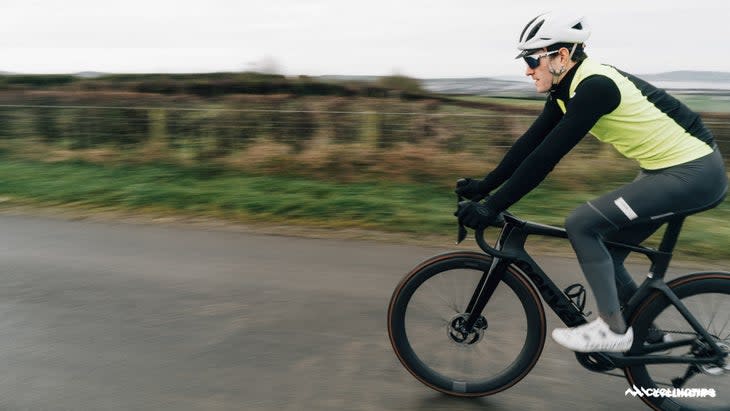
I'm going to skip straight to the final chapter of this review, but before I do, a quick preface. The S5 is a thoroughbred aero race bike. Cervelo has made zero concessions for comfort, serviceability, or ease of use. But given the bike's 'performance at all costs' raison d'etre, I'm ok with most of the less practical design elements on the S5, which I might otherwise find quite jarring were they to feature on a less performance-focused bike. Now with that said, it's on to the review.
I love the new S5, and if it were a book, it should be a favourite for the Pulitzer Prize or sports book of the year awards. We already covered the new S5's simplified front end, improved aerodynamics, and claimed weight savings in my first ride impressions when the new S5 officially launched back in July, so the following are all the reasons the S5 was the page turner I just couldn't put down.
Flicking open the S5's front cover and heading out on a ride, the bike quickly hit me with a storyline that its cover had hidden so well. A story of snappy acceleration, nimbleness, precision handling and pure speed. The opening paragraphs set the tone for every chapter and ride to follow.
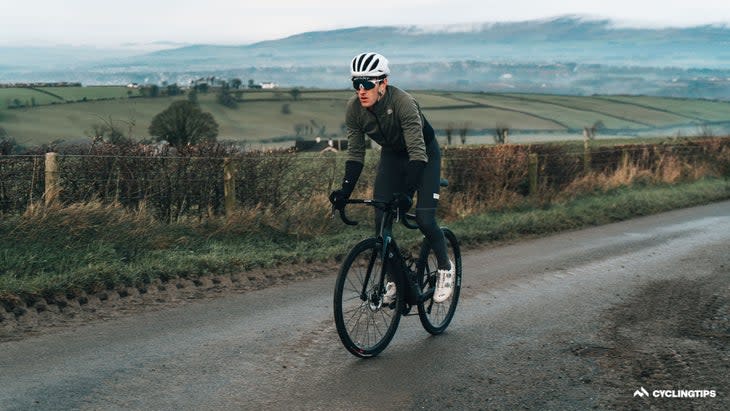
The S5 looks heavy, but it feels and rides so light. It's stiffer than most, but somehow Cervelo has incorporated that stiffness into a bike that rides incredibly smoothly, no doubt aided by the 28 mm tubeless tyres I ran at 65-70 psi. It looks fast, and rides faster. Just how fast? Perhaps not the most scientific measure, but the first ride on the S5 - despite a post-Tour de France fitness slump - told me all I needed to know.
Scientists and aerodynamicists will tell us weight matters little on all bar the most mountainous of routes, and, mathematically, stiffness has no place in the going fast equation. But the S5 suggests otherwise.
At 8.03kg sans pedals, this is a heavy top-end road bike, especially considering the price tag. Judge the S5 by its weight at your peril, though. Despite what the scales say, the S5 feels like a lightweight under me, especially at lower speeds and accelerating. The only explanation I can offer is the S5's sheer stiffness. Initial pedal strokes from a standing start are like a jolt of forward momentum. Sustained seated efforts seem to translate into more speed and, whether uphill or down dale, accelerations feel like race-winning blast-offs.
The proprietary handlebars, V-stem, and nose cone fork are guilty of contributing much of the S5's weight gain, and the front end feels heavier in hand. But in return, the individual components of the front end combine to provide remarkable stiffness and seemingly zero flex. This stiffness is most evident when attacking out of the saddle and hauling on the bars as the S5 offers a sense of forward propulsion.
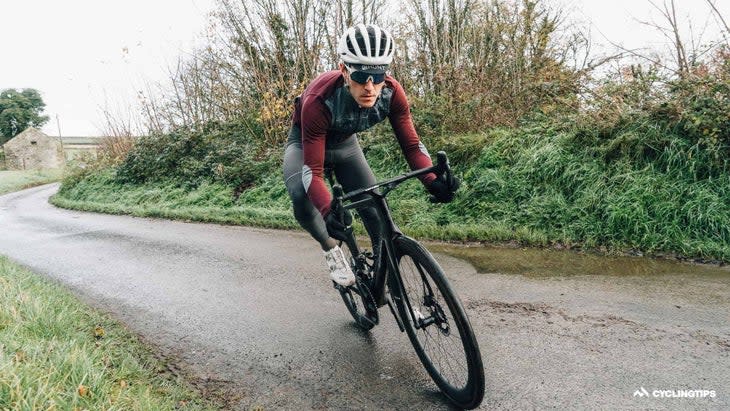
That stiffness is also evident when cornering where the S5 is hugely confidence-inspiring. I've never been the fastest of descenders, and even less so now since my leg malfunction earlier this year. But the S5 inspired and enticed me to go "full send" on every downhill. The steering is precise and predictable, while the bike tracks any line you dare send it on. Even the sensation of simple straight line speed is enthralling. That front-end stiffness and honed Cervelo geometry create one of the most thrilling road bikes I have thrown a leg over. It is as if the extra weight up front even improves the ride.
Yes, you read that right. I believe the extra weight improves the WorldTour-tested, mega-bucks-costing Cervelo S5. That said, I'd love to go full-weight-weenie on the S5 with an endless budget to compare how it might ride at a lower weight.
Geometry
Speaking of geometry, Cervelo has nailed the S5's.
If there is one bit of secret magic in the S5 geometry, it's the compact sizing Cervelo has hidden within what otherwise appears like a huge bike. What do I mean? Take the new Cervelo Soloist, for example. The Soloist shares an identical stack, reach, and effective top tube with the S5. Furthermore, both bikes feature 73deg seat angles and head tubes within half a degree of each other. But the Soloist is 7mm longer on the front centre, the chainstays are also 5mm longer, while the wheelbase is a full 12mm longer, all for the same size 56. I noted how this extra length provided a sense of stability in my review of the new Soloist. How then can the shortened S5 provide the same sensations?
The arrow straight and laser-precise front end shouldn't be all that surprising given the trail figure of 57 mm calculated with the measured 29mm tyres fitted on the S5. If the stiffness and weight weren't enough, this trail figure - often touted as the perfect balance of stability and nimbleness - only adds to the dialled sensation the S5 offers.
The S5's shorter chainstays and rear wheel-hugging seat tube provide much of the S5 magic. Granted, the S5's stack and reach are effective figures incorporating the shorter head tube and necessary V-stem, and the Soloist geometry chart doesn't include the essential headset cap. But, crucially, while the S5 places the bars in more or less the same space in front of me, it pulls the front wheel back a little and really tucks the rear wheel under my rear end, providing a deep sense of connection. The rear wheel felt like it was under me, and so the power delivered to it felt like it was propelling me.
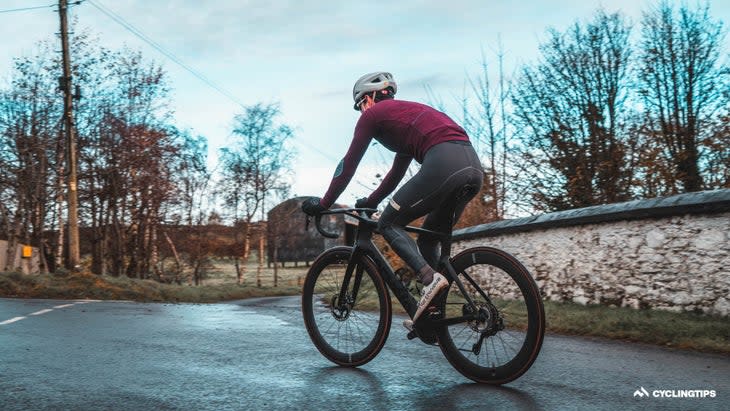
Cervelo has equipped the S5 with sister-brand Reserve's new 53/63 aero wheelset. CyclingTips' global head of tech, James Huang, reviewed these wheels and the technology behind their development at launch back in July, so check out that review for more on the wheels themselves.
As for how they fare on the S5, I found the wheels only add to the sense of stability the S5 already offers. Over the course of this review, I tried five different wheelsets in the S5, and while the bike retains a sense of speed regardless of rim depth or weight, the Reserves offer speed and stability in blustery conditions at a decent weight in a cushier ride than I was expecting with the deeper rim profile. That said, I didn't find the Reserves the stiffest or most responsive wheelset. Among the wheels I tried on the S5, that honour would have to go to the Cadex Ultra 50 or Hunt 60 Limitless UD. But the jury is very much still out on whether increased wheel stiffness equals better performance or if it just feels faster.
You probably get the point by now. I like the S5. I rode faster on the S5, probably partly due to the aerodynamics but likely more because I enjoyed the S5 so much. Always egging me to ride harder and faster, the temptation to indulge in the S5's performance capacity was more often than not impossible to ignore.
The S5 is not without its faults, though. Again - although I found the extra kilogram the S5 is carrying wasn't all that perceptible - many will reasonably expect a lighter build at this hefty price range.
On that point, while the new Ultegra Di2 is phenomenally good, since when is it ok for an Ultegra spec bike to cost a whopping PS9,200? While I can't level all the blame for the rising costs of components from other brands at Cervelo, the ever-rising costs of bikes do worry me. We are simply making our sport inaccessible to countless riders.
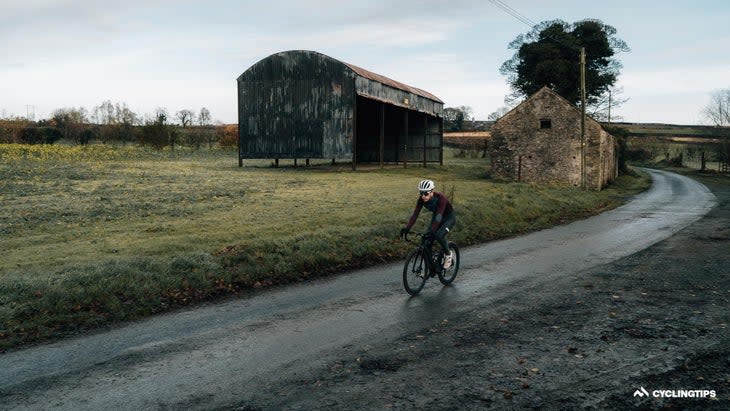
Then there is that front end. Yes, it is simplified, with a single bolt length for all spacer stacks and generally fewer pieces, but it still limits fit adjustability and, needless to say, swapping stem lengths will be a pain. To Cervelo's credit, they have built greater adjustability into the new stem-to-handlebar interface, and the brake hoses now run externally under the handlebar. Still, they are internally routed through the stem.
To be honest, I am ok with that. The S5 is an unapologetically race-focused aero bike, or in other words, the one place I can accept performance taking absolute precedence over serviceability. Sorry mechanics.
I do have a bone of contention with the handlebar width. Given the S5 sacrifices weight, adjustability, and serviceability all in the name of aero and performance gains, it seems peculiar not to spec the bike with narrower bars as standard. My 56 cm review bike came equipped with 42 cm handlebars (c-c). On paper, narrower bars should offer improved aerodynamics and hence be more in keeping with the other performance-focused interventions on the S5. When pressed on the bar width, Cervelo said that based on fit data from riders at Jumbo-Visma, the trend towards narrower bars is not as common as we think. Still, regardless of World Tour rider bike fit trends, narrower bars often make faster riders.
Speaking of bar sizing, though, the HB14 S5 bars are otherwise a refreshingly almost classic-like, race-focused handlebar with 80mm of reach and a mid-depth 128mm of drop on the round drop shape. While not ultra-aggressive, the bars offered me plenty of position differentiation from hoods to drops, something not always the case with some bars.
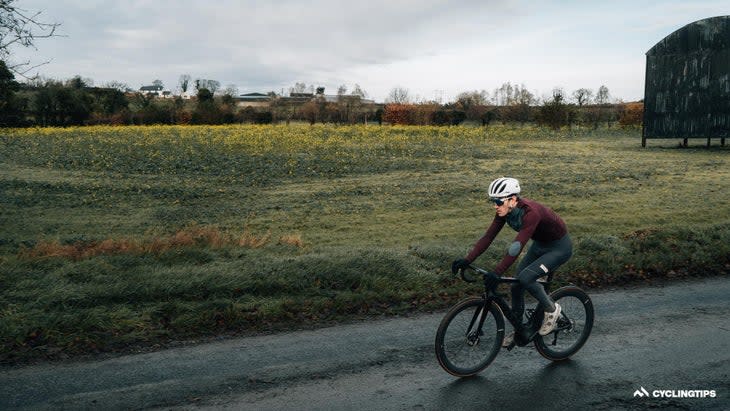
Cervelo has increased tyre clearance right up to 34 mm on the new S5. I don't need to go into the multitude of benefits wider tyres offer, but I do wonder if adding such large capacity on a pure aero bike compromises the potential aero gains Cervelo has already compromised so much - but so well - in chasing. The increased clearance merely increases the gaps between tyres and frame with the 28 mm tyres most S5 riders will likely opt for most of the time. For me, 30 mm of clearance is enough on a dedicated aero race bike.
That said, when I asked Cervelo if 34 mm was overly generous for an aero road bike like the S5, I have to admit their reply suggesting I try the S5 on some gravel roads with 33mm CX tyres was a mouth-watering prospect. Would I ride my own S5 I'd bought and paid for on gravel roads? Probably not. Will I ride Cervelo's S5 on gravel roads at their suggestion? Absolutely.
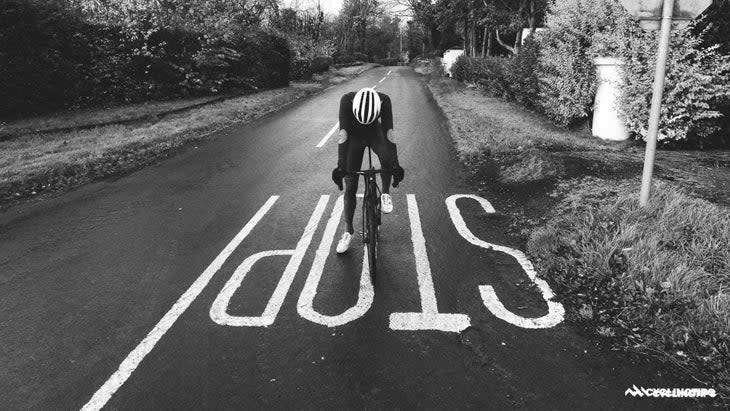
While I love the S5, I do not suggest it is perfect for every rider. It is, once again, an aero race bike, and it is truly a bike for those who value performance over everything. It's stiff, the fit geometry is aggressive, it refuses to do recovery or endurance rides, it's heavy, it's expensive, and the matte and gloss black paint job doesn't do it for me.
The miracle of this bike is that even in spite of all of those things, I can't stop thinking about it. Given the choice, there isn't a single day of the week I'm not taking the S5.
For exclusive access to all of our fitness, gear, adventure, and travel stories, plus discounts on trips, events, and gear, sign up for Outside+ today.

